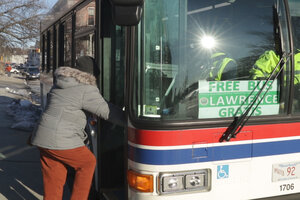Why a small city made bus routes free to low-income residents

LAWRENCE, MASS.
A small Massachusetts city is showing that there are simple, inexpensive ways to improve the lives of low-income residents.
In Lawrence, bus ridership was low in 2018, and at $1.25 a ride the city wasn’t breaking even on its investment. Instead of raising fares to make more money – and pushing riders further away – the city drew $225,000 from its reserves to cover fares for two years on the three routes that start and stop in Lawrence.
“That’s really not a lot of money,” says Mayor Dan Rivera.
Why We Wrote This
As climate change and income inequality spur conversations across the country, many cities are considering changes to make public transportation work better for their citizens. For one city in Massachusetts, that meant making some buses free.
It’s already having an impact. The routes became free in September, and ridership is up 20% from 2018 levels, according to data from Merrimack Valley Regional Transit Authority. (Note: This story was reported just before the worldwide push for social distancing.) With most of the city’s riders making less than $20,000, the free transportation helps. Seniors can now get to the hospital, parents to the supermarket, students to school – all without worrying about the cost.
“They’re very, very grateful,” said Luis Hiraldo, an MRVTA driver. “A lot of people have told me that.”
Lawrence is part of a small but growing number of cities considering the switch. Kansas City, Missouri, and Olympia, Washington, have made bus routes free in the past year, and other cities in Massachusetts view Lawrence as a potential model.
Mr. Rivera’s advice? Just do it. “Test one line, test two lines. ... It’s not like you either have to do everybody free or nobody free,” he said. “You can just do the lines that are important to people in poverty. I think you’ll see an impact there.”

